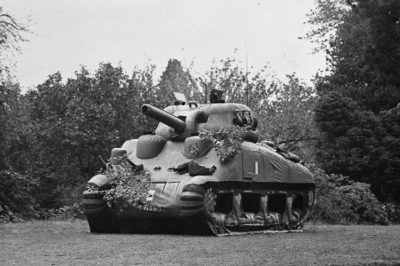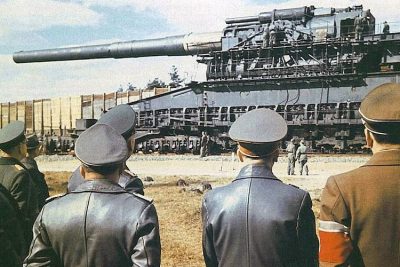Mine Flail: Triggering Mines to Ensure Safety
Share

A mine flail mounted Sherman Crab Mk II in action. (Mapham J (Sgt) / Imperial War Museums)
When we talk about wars and terrorism, we focus on guns, bombs and tanks. We tend to forget the roguish killer that has claimed millions of lives and can be made for a mere price of three dollars – Landmines. Landmine is an explosive that is triggered by pressure or by remote. Throughout the course of history, landmines have been used by countries all around the world to attain military goals.
It is estimated that there are 110 million landmines buried in the ground right now. Landmines can stay active for more than 50 years and therefore pose a real threat to the people. Moreover, minesweeping and neutralizing operations are expensive, costing anywhere between 300 to 1000 US dollars per mine. The rate tends to be higher for developing countries.
History of mine flail
Various demining techniques have been developed since the first world war, but ‘mine flailing’ remains the most eccentric one. In this technique, a device named ‘mine flail’ is attached to the vehicle. The device consists of a rotor to which heavy chains with flails (small steel balls) are attached. The attachment helps mine clearance by intentionally triggering and detonating them. The rotor is mounted in front of the vehicle with the help of two metal arms. The rotor rotates rapidly and swings the flails into the ground generating forces similar to that of footsteps.
This triggers and neutralizes the mines while doing a minimum level of damage to the vehicle. In ideal conditions, mine flailing can successfully demine the land to an extent of 100 percent. This approach to mine clearance was first adopted by the British during the second world war. The British came across the problem of landmines twice. For the first time when Hitler threatened to invade the United Kingdom. As a precautionary measure, Britain had buried over 350,000 landmines across the beaches to prevent Nazi invasion. When Hitler changed his mind, these mines had to be removed.
They faced the same problem for the second time when the allied forces were advancing towards Germany. During the war, mines, specifically, landmines formed the backbone of the German offence and defence. Germans used landmines to block paths, divert and slow down advancing allied troops. But if the troops somehow managed to cross the deadly minefields without any casualties, they could easily flank the enemy.

Mine flail mounted on valentine (tank). (UK Gov / Wikimedia Commons)
Other prototypes
As a result, the development of mine flails took place. In 1942, ‘Matilda Scorpion’ was developed. This was a modified Matilda tank fitted with a mine flail. The flails were powered by a secondary V8 Ford engine. Twenty-five of such Scorpions helped the Allied forces to cross the fields near El Alamein (referred as the ‘Devil’s Garden’) which had almost 3 million landmines.
The process was quite tedious and slow. The tank had to clear mines under the fire of German gunners. However, the flails managed to create a screen of dust that obstructed the German line of sight. The crew had to wear a gas mask in order to breath. The performance of the tank was not on par with the expectations, the flails broke down and the engine failed occasionally. However, the tank managed to do the work.

Close up of modified Matilda scorpion tank in operation. (No 2 Army Film & Photographic Unit, Whicker (Lt) / Imperial War Museums)
After the battle of El Alamein, the technology was further developed and several flail tanks were made, the most notable one being “the Crab” which was a modified Sherman tank. Several innovative developments were made in this flail tank. It had chains modified to cut barbed wires and used chalk to mark the lane swept clear of mines.
Also, the flails were powered by the tank’s engine itself. However, the process of mine clearing was still very slow as ‘The Crab’ could move at a speed of only 2 kmph while flailing. Also, the tank could not fire at the enemy as the main turret had to point backwards while flailing. Sherman Crabs, today, are displayed in museums across the globe, including Canada, Netherlands, India, and England.
Mine flails are still in use. They are used in third world countries where major landmass is affected by landmines buried years ago. However, the purpose of operation has changed entirely from war to humanitarian purpose. The vehicles are unarmed and yield only the amour necessary to withstand the blast.
Now, ‘Mine flails’ are not exclusive to the tanks, they are also mounted to trucks and remote-controlled armoured cabs. It still is the most rapid mine clearing method but, really expensive to operate. Also, it doesn’t yield a 100 percent success rate every time. UN has set the safety criteria as 99.4%, but mine flails sometimes clear only 50-60 percent of the mines.
Recommended Visit:
Base Borden Military Museum | Canada
Fact Analysis:
STSTW Media strives to deliver accurate information through careful research. However, things can go wrong. If you find the above article inaccurate or biased, please let us know at [email protected]













